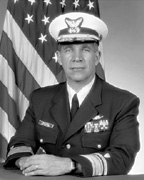|
The U.S. Coast Guard’s combination hat gets its name from being a combination of the white cap and Coast Guard blue. “The front piece of the cap for the non-rated personnel and Petty Officers has the Coast Guard emblem on it; the front piece for Chief Petty Officers’ caps have a fouled anchor with a Branch of Service Shield over the center of the anchor, and the officers’ caps have an open winged eagle with its talons on a fouled anchor,” says Joseph DeBlase, chief clothing designer for the Coast Guard. “All of these insignia have the Branch of Service Shield on the front, which has 13 stars symbolizing the original 13 colonies.” DeBlase states that the Coast Guard combination hat is larger than similar headwear worn by other branches of the military. “The front is higher, and it’s lower in the back. The brim is made of a poromeric material, and it has a natural sheen to it, so there is no need for it to be shined. Also, the actual circumference is greater.” Like the uniforms of most industries, there is a constant evolution due to cultura and job function changes and fabric innovations. While the traditional appearance to military uniforms may seem unchanging to the casual observer, there have been many variations since the Coast Guard was founded as the Revenue Marine Cutter Service in 1790. For example, its uniform, in particular, has evolved from one appropriate to the harsh duties of sailing wooden ships to a utility uniform that is more militaristic in style as its sailors patrol the waterways, ready to save but also ready to interdict the drug trade and other forms of smuggling that have grown in recent years. “The Coast Guard began as an organization created to fight the rampant smuggling that threatened our fledgling nation,” recounts DeBlase. “We’ve gone through amazing growth and change as new missions of humanitarian service were added and other agencies were merged to create the Coast Guard of today. Although we are a military service and also have a wartime mission, we’re part of the Department of Transportation, not Defense. Going back a bit, we used to be a part of the Treasury Department. Depending upon which departament we’ve been assigned to and the nature of our duties, the uniforms would change accordingly, while continuing to reflect our roots as a seagoing service with maritime missions. The combination hat originally comes from the Navy design.” The present version of the combination hat has been in use for just over a decade but originated 104 years ago. Petty Officer Suzanne Bradford of the Coast Guard’s Clothing Design and Technical Office explains that on June 12, 1897, embroidered visors for senior officers were introduced, very similar to those worn today. Bradford quotes from the book The Uniforms of the United States Navy, by James C. Tily (information supplied by the Institute of Heraldy), which outlines part of the historical relationship between Navy and Coast Guard apparel: “The visors of the caps of rear admirals, commodores, captains and commanders were to be covered with dark blue cloth. All other commissioned officers were to wear caps with black patent leather visors. The visors of caps of line rear admirals and commanders were to be embroidered ‘all around’actually, all overwith oak leaves and acorns. Staff officers of corresponding relative rank had a band of embroidery half an inch wide around the front edge and back of the visor, the blue of the background appearing in between. Line captains and commanders had a border of oak leaves and acorns on the front edge of the visor only, and staff officers of comparable rank had a half-inch band around the front. The oak leaf and acorn motif had its origin in the decoration prescribed for the full-dress body coat of 1830. In the visor ornamentation, the change elaborated the method of differentiating between line and staff.” Those in the military refer to the decorative emblem on the front of senior officers’ caps as “scrambled eggs.” On the Coast Guard hat, it is comprised of oak leaves and acorns that are derived from a Navy coat circa 1830. “The oak tree is a symbol of great and enduring strength. Ships used to be built from oak,” DeBlase explains. Cindee Herrick of the Coast Guard Museum explains that oak leaves are a symbol of authority dating back to Roman times and earlier. Roman emperors and senators were crowned with wreaths of oak leaves. The oak is an ancient fertility symbol of the male principal. For the Romans, it was a symbol of service to the state. In some cultures, the oak tree is holy. It has taken on civic authority in some cultures where marriages and trials were performed under an oak tree. All services except the Air Force use oak leaves and acorns on the visors of their combination hat. The Air Force has a motif of clouds and lighting bolts in silver on their service cap visor. Despite its fascinating history of achievement and sacrifice under the auspices of multiple branches of the federal government, the United States Coast Guard has, in the past, always been overshadowed by the other four services of the U.S. military in the layman’s consciousness. As the times continue to change and the Coast Guard plays an ever more crucial role in our nation’s defense, our understanding and appreciation of its storied tradition will growscrambled eggs and all. |
| Above story first appeared in MADE TO MEASURE Magazine, Fall & Winter 2001 issue. All rights reserved. Photos appear by special permission. |
| Halper Publishing Company 633 Skokie Blvd, #490 Northbrook, IL 60062 (847) 780-2900 Fax (224) 406-8850 [email protected] |











